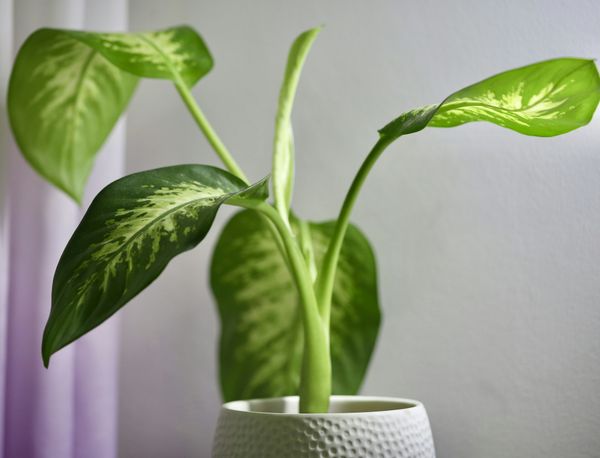Dumb Cane Care Guide
How to grow and care for Dumb Cane (Dieffenbachia spp.)
Dieffenbachia spp., commonly known as Dumb Cane, is a popular indoor houseplant known for its striking foliage and ease of care. With its broad, variegated leaves, this tropical plant can add a touch of lush, green beauty to any indoor space. Whether you're new to plant care or a seasoned gardener, the Dumb Cane is a rewarding plant that can thrive indoors with proper attention.

Disclosure: This content includes affiliate links, which means we may earn a commission if you click on a link and make a purchase. As an Amazon Associate, we earn from qualifying purchases. This comes at no extra cost to you and helps offset the cost of running Leafwise. Please read our disclaimer for more info.
Table of Contents
Care
Light
Dieffenbachia thrives in bright, indirect light but can tolerate lower light conditions. Avoid direct sunlight, as it can scorch the leaves. For optimal growth, place the plant near an east-facing or filtered south-facing window where it receives gentle, indirect light. While it can survive in lower light, reduced light may result in slower growth and less vibrant variegation.
Watering
Water when the top inch of soil feels dry to the touch. Water thoroughly, allowing excess water to drain out of the pot. Ensure the pot has proper drainage to prevent waterlogging and root rot. Reduce watering in the winter when the plant’s growth slows.
Humidity & Temperature
Maintain temperatures between 65°F and 75°F (18°C and 24°C). Dieffenbachia thrives in moderate to high humidity. To increase humidity, mist the leaves regularly, use a humidifier, or place the plant near a pebble tray filled with water. Avoid cold drafts or sudden temperature changes, as these can cause leaf damage.
Soil
Use a well-draining potting mix to keep the soil evenly moist but never soggy. A mix of peat moss, perlite, and potting soil works well to provide aeration and proper moisture retention. Slightly acidic soil with a pH between 6.1 and 6.5 is ideal.
Fertilization
Feed with a balanced, water-soluble fertilizer once a month during the growing season (spring and summer). Some sources recommend biweekly fertilization if the plant is in bright, indirect light. Reduce or stop fertilization in fall and winter when the plant’s growth slows.
Maintenance
Pruning
Regularly prune any yellow, dead, or damaged leaves to encourage new growth and maintain the plant’s appearance. Use clean, sharp pruning shears to prevent the spread of diseases.
Cleaning
Wipe the leaves with a damp cloth to remove dust, which can inhibit photosynthesis. Clean leaves also help deter pests and promote healthy growth.
Repotting
Repot every 2-3 years or when the plant outgrows its container. Choose a pot that is 1-2 inches larger and refresh the soil with a well-draining potting mix.
Propagation
Dieffenbachia propagates easily through stem cuttings:
- Select a healthy stem – Choose a cutting with several nodes and leaves.
- Make a clean cut – Use sterilized pruning shears to cut the stem just below a node.
- Root in water or soil – Place the cutting in water (changing the water weekly) or plant it directly in moist soil.
- Provide optimal conditions – Keep the cutting in a warm, humid environment with bright, indirect light.
- Transplant – Once roots develop (in 4-6 weeks), transfer the cutting to a pot with fresh soil.
Common Issues
Yellowing Leaves
Cause: Overwatering, insufficient light, or nutrient deficiencies.
- Solution: Check the soil moisture and improve drainage if overwatering is the issue. Move the plant to a location with more indirect light if lighting is insufficient. If nutrient deficiency is suspected, apply a balanced fertilizer during the growing season.
Brown Leaf Tips
Cause: Low humidity, underwatering, or exposure to fluoride or salts from tap water.
- Solution: Increase humidity by misting or using a humidifier. Water the plant consistently and use filtered or distilled water to avoid fluoride buildup.
Drooping Leaves
Cause: Underwatering, overwatering, or temperature stress.
- Solution: Check the soil’s moisture level. If the plant is underwatered, provide a thorough watering. If overwatered, let the soil dry partially before the next watering. Ensure stable temperatures and avoid cold drafts.
Pests (Spider Mites, Mealybugs, Aphids)
Cause: Dry indoor conditions, poor airflow, and dusty leaves can attract pests.
- Solution: Wipe the leaves with a mixture of water and mild soap or use insecticidal soap or neem oil. Improve humidity and clean the leaves regularly to prevent pest buildup.
Root Rot
Cause: Overwatering and poor drainage.
- Solution: Remove the plant from its pot and inspect the roots. Trim off any mushy or blackened roots and repot in fresh, well-draining soil. Adjust watering habits to prevent future issues.
Toxicity Warning
Dieffenbachia contains calcium oxalate crystals, which are toxic if ingested by humans or pets. Ingestion can cause irritation, swelling of the mouth, and temporary inability to speak. Keep the plant out of reach of children and pets to ensure safety.
By following these care tips, your Dieffenbachia will reward you with vibrant, healthy foliage, making it a stunning addition to your indoor space.
